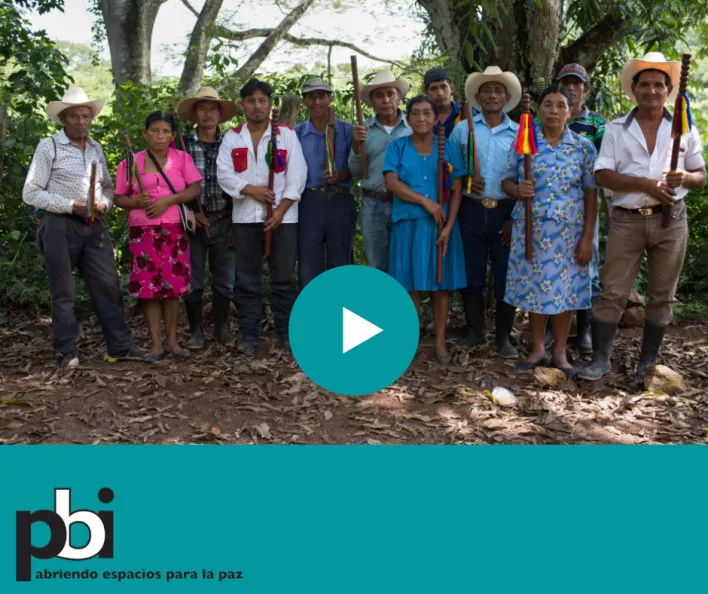“We are determined to keep fighting.”

In february 2020, the Olopa Resistance celebrated its first anniversary of the installation of a sit-in on the road to the mine. This short video tells about the struggle of the Peaceful Resistance of Olopa, accompanied by Nuevo Dia, against the mining project that started its activities in their territory without a prior, free and informed consultation.

We are organized and ready to fight.
For our children, there is nothing that will stop us.
Today, under the sun, the rain, through hunger,.
I’m singing for our life and our land.
Song “Olopa Resists”- Ubaldino García
PBI has been accompanying the New Day Ch’orti’ Campesino Central Coordinator (CCCND) since 2009. This organization works in Maya Ch’orti’ communities from the department of Chiquimula. Their mission is to advise and accompany the communities in their processes to defend their territory, access to land and secure recognition as indigenous communities. One of the processes that CCCND supports is that of the Peaceful Resistance to the “Cantera Los Manantiales” mine, in the municipality of Olopa. This process seeks to defend the Ch’orti’ territory and the environment in the absence of consultation with the populations affected by mining activities.
The “Cantera Los Manantiales” Mine
In 2012, Otto Pérez Molina’s government, through the Ministry of Energy and Mines (MEM), granted the American Minerals S.A. company an exploitation license for antimony extraction that was to be valid for 25 years. The land on which this extractive Project was to be carried out is located in the village of El Carrizal, which belongs to the municipality of Olopa, and covers an area of two square kilometers. This license was granted without having carried out a free, prior and informed consultation with the affected communities, as stipulated in the International Labor Organization’s (ILO) Convention 169. Despite this, the company initiated operations in 2016.
The communities soon realized that the antimony extraction was causing a series of negative impacts on the water and the environment.1 For this reason, the indigenous authorities, together with several people from the community, concluded that this economic initiative that had been promoted by the State would not result in the development that they had been promised and, therefore, had to be stopped before the damages it was causing became irreversible.
“We are opposed to the mine because it has caused illness, destruction of the forest and loss of our crops.”2
“We realized that the fish were beginning to die in large quantities. Some children from the community who do not have water in their homes go down to the ravine to wash their clothes and dishes… they noticed that this water was totally affected by pollution from the waste material that they were removing from the mine. This is how we started the current protest.”3
“There used to be a pretty mountain, but they cut down the entire forest and what they have destroyed won’t be rebuilt. If campesinos chop wood, they must plant more; but nothing is demanded of the powerful, they can take what they want and replace nothing.”4
The struggle to defend the territory
Having witnessed the negative effects of the mining project, the people from these communities began their peaceful struggle in order to express their rejection of the mine and achieve its definitive closure. Although the members of this peaceful resistance carried out numerous activities to halt the mine, they have not managed to stop its operations: “We have raised so many complaints, we have led so many marches, but we are not listened to because we have no money … .”5
Since the Resistance began, its members have faced risks in their struggle to protect nature and the environment. From January 2016 22 of their leaders began to be criminalized as a result of their non-violent actions in defense of the territory. They were accused of crimes such as causing injuries through violent altercations, raids, threats and aggravated arson. Despite the fact that the criminal prosecution was resolved two months after the accusation, through a judicial conciliation, security incidents did not cease. On the contrary, they returned with more force during 2018. There were several episodes of surveillance that year as the mine continued to operate, as well as constant intimidation and numerous threats to members of the resistance and to the CCCND coordination. It was within context of these tensions, that Elizandro Pérez, 36-year-old Indigenous Authority, resident of La Prensa – a community near to the mine – and a member of the resistance, was found dead at his home in November 2018.6 While the circumstances surrounding his death have not yet been clarified, it should be noted that Elizandro had been the target of repeated intimidation and death threats for his participation in the defense of the territory in the months prior to his death.7
The exhaustion caused by the continuous aggression, as well as the grief from the loss of one of their leaders, led the Resistance to agree to a road map outlining the steps they would follow. In November 2018, the resistance organized an “in situ” inspection of the villages near the mine, in which the MEM and the Ministry of Environment and Natural Resources (MARN) participated. The objective of the inspection was to verify the environmental damage caused by the mine and conduct an environmental impact study of the mine.8 On February 25, 2019, all parties met again to examine the results of this inspection. The indigenous authorities reiterated their request that the communities’ decision regarding the absolute closure of the mine be respected at this meeting. In turn, the MARN presented its environmental impact study which certified that the mine did not meet the environmental and legal requirements. As a result the resistance requested the official suspension of the environmental license for the mining project, the immediate and indefinite closure of the mine, the withdrawal of machinery and the end of the intimidation and attacks against the Resistance.
The Camp at La Prensa and El Carrizal as a form of peaceful resistance
On the same day that MARN ordered the suspension of the license, February 25, 2019, community members from the municipality of La Prensa and members of CCCND declared themselves to be in a Permanent Assembly and installed a peaceful camp at the entrance of the mine9: “The idea of organizing a camp came from the communities themselves when they saw the disaster that the mine had caused to Mother Nature. They thought of forming a non-violent, peaceful resistance to counteract the disaster.”10 The objective of this camp was to ensure that MARN decisions were executed and that the mine would be closed and all the machines removed within 15 working days.
The La Prensa camp is active 24 hours a day, Monday through Sunday: “There are people from six communities who take turns every day. Every 24 hours we hand over to people from another to continue monitoring the situation and to ensure that the company does not return to the mine again.”11 On April 8, 2019, a second sit-in was formed at the other entrance to the mine, near the El Carrizal community. Under the observation and the pressure exerted by both camps, the owners withdrew all the machinery, but the sit-ins have continued because the owners have threatened to re-enter and continue their extractive activities on several occasions.
The continuous presence of the protest camps, all day and night, carries a series of risks for the members of the resistance. There have been constant death threats, intimidation, shootings into the ground and air, surveillance, lawsuits and attempts to co-opt their members. The resistance has identified that those responsible for such incidents are workers from the company who live in nearby communities. This permanent insecurity for members of the resistance profoundly affects their lives, as it takes them away from their homes, their jobs, the care of their families, and also has emotional impacts.
“I have been in the struggle and have had serious problems being there, for defending Mother Earth. There have been both moments of sadness and joy, both, I tell you.”12
“There are difficult moments at the camp, moments when we despair because security staff from the mine pass in front of us, armed. We feel intimidated by them because we don’t use weapons. Our ideas are our only weapons.”13
“We have to be there day and night, and it’s impossible to sleep, instead we are suffering. Still the miners’ bodyguards shoot every night. So there is a risk. Those gunmen shot at my husband and I, but thank God, they didn’t hit us. Well, the fact is that the struggle keeps us so busy, that we neglect our homes, our work, we leave our corn in the fields and sometimes people just take it. We are worried because we fall behind and are no longer earning our keep. We are very worried, that is why we want to evict the mine, because they are taking our lives, it is a loss of life.”14
The injunction at the Supreme Court of Justice, hope for the future
In the face of inactivity from several State institutions, CCCND and the resistance took a decisive step towards the definitive closure of the mine and in defense of the environment and the Ch’orti ’territory. In August 2019, several indigenous authorities from the Olopa communities traveled to Guatemala City to deliver an injunction to the Supreme Court of Justice. The injunction demands the communities’ rights to prior, free and informed consultation on the mining activities of the “Cantera Los Manantiales” company. This action is very significant for the organization and the resistance, as the protection could lead to the indefinite closure of the mine.
“We hope that the licenses granted by the MEM be will canceled so that all the problems we have are over.”15
“Today we are here with the intention of presenting the injunction to see if we can have solution and rest a little from this resistance.”16
The main concern of the Resistance is, without a doubt, the fate of future generations: “We know that it hurts us, especially the new generation that is coming. We have lost most of nature. It was a very sacred place that was lost by the the company’s activities.”17
“The mine created a great disaster there, there is no firewood, there is nothing, it is already desert. What’s left? We are concerned for the coming future. What are we going to leave to our children?” 18
These brave and tenacious men and women have been able to transform their indignation, anguish and hopelessness into motivation and courage in favor of life. This is their energy to keep struggling.
1Arreaga, S., Antimonio: el veneno de la comunidad Ch’orti’, Prensa Comunitaria, 09.11.2018.
2Interview with Don Erasmo, member of the El Carrizal camp, August 2019.
3Interview with Don Chico, indigenous authority and member of the El Carrizal camp, August 2019.
4Interview with Doña Carmelita, indigenous authority and member of the El Carrizal camp, August 2019.
5 Interview with Doña Carmelita, August 2019.
6Communique CCCND, Encuentran sin vida a autoridad ch´orti´ Elizandro Peréz, 21.11.2018
7Redacción, La no tan misteriosa muerte de Elizandro Pérez, autoridad del pueblo ch’orti’, Prensa Comunitaria, 22.11.2018.
8Arreaga, S., Op. Cit.
9Ajpu, N., Comunidades indígenas Ch’orti’ se declaran en asamblea permanente y resistencia pacífica contra minera, 27.02.2019.
10Interview with Don Erasmo, Cit.
11Interview with Don Chico, Cit.
12Interview with Don Erasmo, Cit.
13Interview with Don Chico, Cit.
14Interview with Doña Carmelita, Cit.
15Interview with Don Erasmo, Cit.
16Interview withDoña Carmelita, Cit.
17Interview with Don Chico, Cit.
18Entrevista a Doña Carmelita, Cit.
